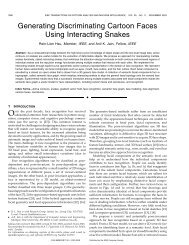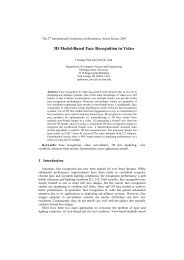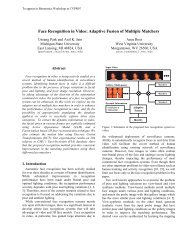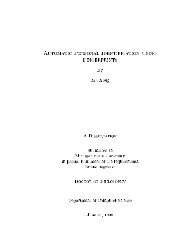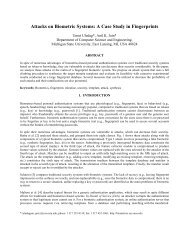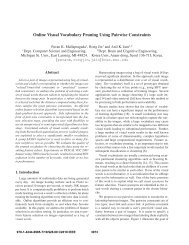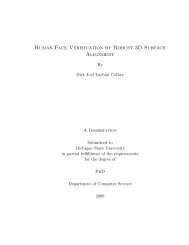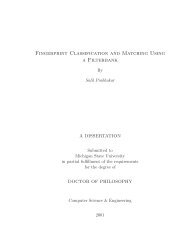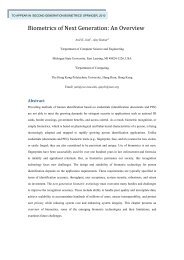Face Detection and Modeling for Recognition - Biometrics Research ...
Face Detection and Modeling for Recognition - Biometrics Research ...
Face Detection and Modeling for Recognition - Biometrics Research ...
Create successful ePaper yourself
Turn your PDF publications into a flip-book with our unique Google optimized e-Paper software.
1.5.3 <strong>Face</strong> Alignment Using Interacting Snakes<br />
For the semantic recognition system (shown in Fig. 1.12), we define a semantic face<br />
graph. A semantic face graph is derived from a generic 3D face model <strong>for</strong> identifying<br />
faces at the semantic level. The nodes of a semantic graph represent high-level facial<br />
components (e.g., eyes <strong>and</strong> mouth), whose boundaries are described by open (or<br />
closed) active contours (or snakes). In our recognition system, face alignment plays<br />
a crucial role in adapting a priori knowledge of facial topology, encoded in semantic<br />
face graph, onto the sensed facial measurements (e.g., face images). The semantic<br />
face graph is first projected onto a 2D image, coarsely aligned to the output of the<br />
face detection module, <strong>and</strong> then finely adapted to the face images using interacting<br />
snakes.<br />
Snakes are useful models <strong>for</strong> extracting the shape of de<strong>for</strong>mable objects [77].<br />
Hence, we model the component boundaries of a 2D semantic face graph as a collection<br />
of snakes. We propose an approach <strong>for</strong> manipulating multiple snakes iteratively,<br />
called interacting snakes, that minimizes the attraction energy functionals on both<br />
contours <strong>and</strong> enclosed regions of individual snakes <strong>and</strong> the repulsion energy functionals<br />
among multiple snakes that interact with each other. We evaluate the interacting<br />
snakes through two types of implementations, explicit (parametric active contours)<br />
<strong>and</strong> implicit (geodesic active contours) curve representations, <strong>for</strong> face alignment.<br />
Once the semantic face graph has been aligned to face images, we can derive<br />
component weights based on distinctiveness <strong>and</strong> visibility of individual components.<br />
The aligned face graph can also be easily used to generate cartoon faces <strong>and</strong> facial<br />
25



